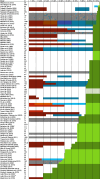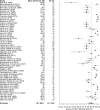Conceptual coherence but methodological mayhem: A systematic review of absolute pitch phenotyping
- PMID: 39838215
- PMCID: PMC11750914
- DOI: 10.3758/s13428-024-02577-z
Conceptual coherence but methodological mayhem: A systematic review of absolute pitch phenotyping
Abstract
Despite extensive research on absolute pitch (AP), there remains no gold-standard task to measure its presence or extent. This systematic review investigated the methods of pitch-naming tasks for the classification of individuals with AP and examined how our understanding of the AP phenotype is affected by variability in the tasks used to measure it. Data extracted from 160 studies (N = 23,221 participants) included (i) the definition of AP, (ii) task characteristics, (iii) scoring method, and (iv) participant scores. While there was near-universal agreement (99%) in the conceptual definition of AP, task characteristics such as stimulus range and timbre varied greatly. Ninety-five studies (59%) specified a pitch-naming accuracy threshold for AP classification, which ranged from 20 to 100% (mean = 77%, SD = 20), with additional variability introduced by 31 studies that assigned credit to semitone errors. When examining participants' performance rather than predetermined thresholds, mean task accuracy (not including semitone errors) was 85.9% (SD = 10.8) for AP participants and 17.0% (SD = 10.5) for non-AP participants. This review shows that the characterisation of the AP phenotype varies based on methodological choices in tasks and scoring, limiting the generalisability of individual studies. To promote a more coherent approach to AP phenotyping, recommendations about the characteristics of a gold-standard pitch-naming task are provided based on the review findings. Future work should also use data-driven techniques to characterise phenotypic variability to support the development of a taxonomy of AP phenotypes to advance our understanding of its mechanisms and genetic basis.
Keywords: Absolute pitch; Heritability; Methods; Phenotype.
© 2025. The Author(s).
Conflict of interest statement
Declarations. Conflict of interest: The authors declare no conflicts of interest pertaining to this manuscript. Ethics approval: As a review of published data, no ethics approval was required. Consent to participate: Not applicable. Consent for publication: Not applicable.
Figures















Similar articles
-
Use of explicit priming to phenotype absolute pitch ability.PLoS One. 2022 Sep 14;17(9):e0273828. doi: 10.1371/journal.pone.0273828. eCollection 2022. PLoS One. 2022. PMID: 36103463 Free PMC article.
-
Auditory working memory predicts individual differences in absolute pitch learning.Cognition. 2015 Jul;140:95-110. doi: 10.1016/j.cognition.2015.03.012. Epub 2015 Apr 20. Cognition. 2015. PMID: 25909580
-
Absolute pitch memory: its prevalence among musicians and dependence on the testing context.Psychon Bull Rev. 2014 Apr;21(2):534-42. doi: 10.3758/s13423-013-0487-z. Psychon Bull Rev. 2014. PMID: 23943554
-
Absolute pitch: music and beyond.Epilepsy Behav. 2005 Dec;7(4):578-601. doi: 10.1016/j.yebeh.2005.05.019. Epub 2005 Aug 15. Epilepsy Behav. 2005. PMID: 16103017 Review.
-
On the Perceptual Subprocess of Absolute Pitch.Front Neurosci. 2017 Oct 6;11:557. doi: 10.3389/fnins.2017.00557. eCollection 2017. Front Neurosci. 2017. PMID: 29085275 Free PMC article. Review.
References
-
- Abdellaoui, A., & Verweij, K. J. H. (2021). Dissecting polygenic signals from genome-wide association studies on human behaviour. Nature Human Behaviour,5, 686–694. 10.1038/s41562-021-01110-y - PubMed
-
- Acevedo, S., Temperley, D., & Pfordresher, P. Q. (2014). Effects of metrical encoding on melody recognition. Music Perception,31, 372–386. 10.1525/mp.2014.31.4.372
-
- Akiva-Kabiri, L., & Henik, A. (2012). A unique asymmetrical Stroop effect in absolute pitch possessors. Experimental Psychology,59, 272–278. 10.1027/1618-3169/a000153 - PubMed
-
- Aruffo, C., Goldstone, R. L., & Earn, D. J. D. (2014). Absolute judgment of musical interval width. Music Perception,32, 186–200. 10.1525/MP.2014.32.2.186
-
- Athos, E. A., Levinson, B., Kistler, A., Zemansky, J., Bostrom, A., Freimer, N., & Gitschier, J. (2007). Dichotomy and perceptual distortions in absolute pitch ability. Proceedings of the National Academy of Sciences of the United States of America,104, 14795–14800. 10.1073/pnas.0703868104 - PMC - PubMed
Publication types
MeSH terms
LinkOut - more resources
Full Text Sources

